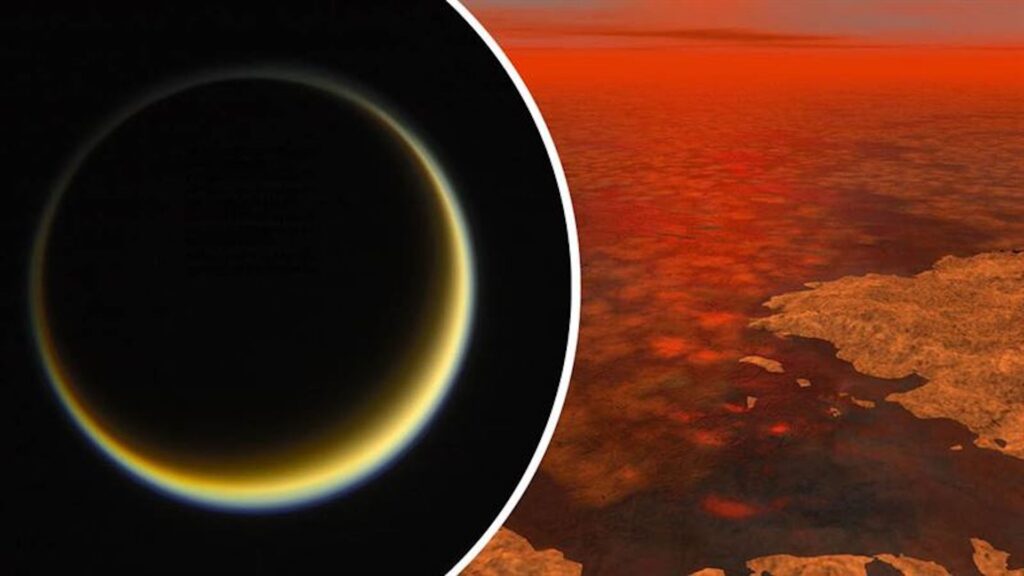The frigid conditions on the surface of Saturn’s largest moon, Titan, allow simple molecules in its atmosphere to break one of the most fundamental rules in chemistry, a new study shows.
According to this principle, known as “like dissolves like,” mixtures containing both polar and nonpolar components, such as oil and water, usually don’t mix and instead form separate layers.
“This contradicts a rule in chemistry, ‘like dissolves like,’ which basically means that it should not be possible to combine these polar and nonpolar substances,” lead study author Martin Rahm, an associate professor of chemistry, biochemistry and chemical engineering at the Chalmers University of Technology, said in a statement.
The new study, published July 23 in the journal PNAS, challenges a long-held pillar of chemistry and could open the door to the discovery of more exotic solid structures across the solar system.
Re-creating Titan’s surface
Conditions on Titan’s surface bear a striking resemblance to those of early Earth, research suggests. Its atmosphere contains high levels of nitrogen and the simple hydrocarbon compounds methane and ethane, which cycle in a localized weather system, much like Earth’s water cycle.
However, until now, researchers were unsure about the fate of the hydrogen cyanide produced by reactions in this atmosphere. Is it deposited on the surface as a solid? Does it react with its surroundings? Or could it be converted into the first molecules of life?
To investigate these questions, the NASA team replicated the conditions on Titan’s surface by combining mixtures of methane, ethane and hydrogen cyanide at temperatures of around minus 297 degrees Fahrenheit (minus 183 degrees Celsius). A spectroscopic analysis — a way of studying chemicals through their interactions with different wavelengths of light — yielded unexpected results, suggesting that these contrasting compounds were interacting much more closely than had ever been observed before.
It appeared that molecules of nonpolar methane and ethane had slotted into gaps in the solid crystal structure of the hydrogen cyanide — a process known as intercalation — to create an unusual co-crystal containing both sets of molecules.
Ordinarily, polar and nonpolar molecules don’t mix. Polar compounds, such as water and hydrogen cyanide, have an uneven distribution of charge across the molecule, creating some areas that are slightly positive and others that are slightly negative. These oppositely charged regions are attracted to each other, forming strong intermolecular interactions between the different polar molecules and largely ignoring any nonpolar components.

Meanwhile, nonpolar oils and hydrocarbons have an entirely symmetrical arrangement of charge and interact very weakly with neighboring nonpolar molecules and not at all with polar particles. As a result, mixtures containing both polar and nonpolar components, such as oil and water, usually form distinct layers.
To explain their bizarre observations, the NASA team joined forces with researchers at the Chalmers University of Technology to model hundreds of potential co-crystal structures, assessing each for its probable stability under the conditions on Titan.
“Our calculations predicted not only that the unexpected mixtures are stable under Titan’s conditions but also spectra of light that coincide well with NASA’s measurements,” Rahm explained.
Their theoretical analysis identified several possible stable crystal forms, which they propose are stabilized by a surprising boost in the strength of the intermolecular forces in the hydrogen cyanide solid triggered by this mixing.
Their rigorous combination of theory and experiment impressed Athena Coustenis, a planetary scientist at the Paris-Meudon Observatory in France. She is excited to see how future data, including that from NASA’s Dragonfly probe (due to arrive on Titan in 2034), will complement the study’s findings.
“Comparing laboratory spectra with upcoming Dragonfly mission data may reveal signatures of these solids on Titan’s surface, providing insight into their geological roles and potential importance as low-temperature, prebiotic reaction environments,” Coustenis told Live Science in an email. Further work could even expand this approach to other molecules likely generated by Titan’s atmosphere, including cyanoacetylene (HC3N), acetylene (C2H2), hydrogen isocyanide (HNC), and nitrogen (N2), she said. “[This] will test whether such mixing is a general feature of Titan’s organic chemistry.”
